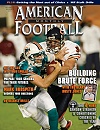Article CategoriesAFM Magazine
|
Drills Report: Wide Receiver Stalk Blockingby: Luke PowellWide Receivers Coach Indiana State University © More from this issue Statistically, we had our best offensive season in decades, if not ever, at Indiana State in 2010. Our scoring average improved from 9.0 points per game to 31.9 points per game. A major factor in the increased production was our efficiency in the running game. In 2009, we averaged just 97 yards rushing per game. Compare that to the 193-yards rushing per game we had this season. Getting receivers to buy into their importance in the run game can sometimes be challenging. Receivers always want the ball to be thrown to them. However, you cannot consistently break long runs without great blocking downfield by the receivers. There are different techniques receivers can use based on the play call or situation, such as the push-crack vs. a run-support safety and the cut-block vs. an overly aggressive cornerback. Below, I....The full article can only be seen by subscribers.
|
|
|||||||
| HOME |
MAGAZINE |
SUBSCRIBE | ONLINE COLUMNISTS | COACHING VIDEOS |
Copyright 2025, AmericanFootballMonthly.com
All Rights Reserved





